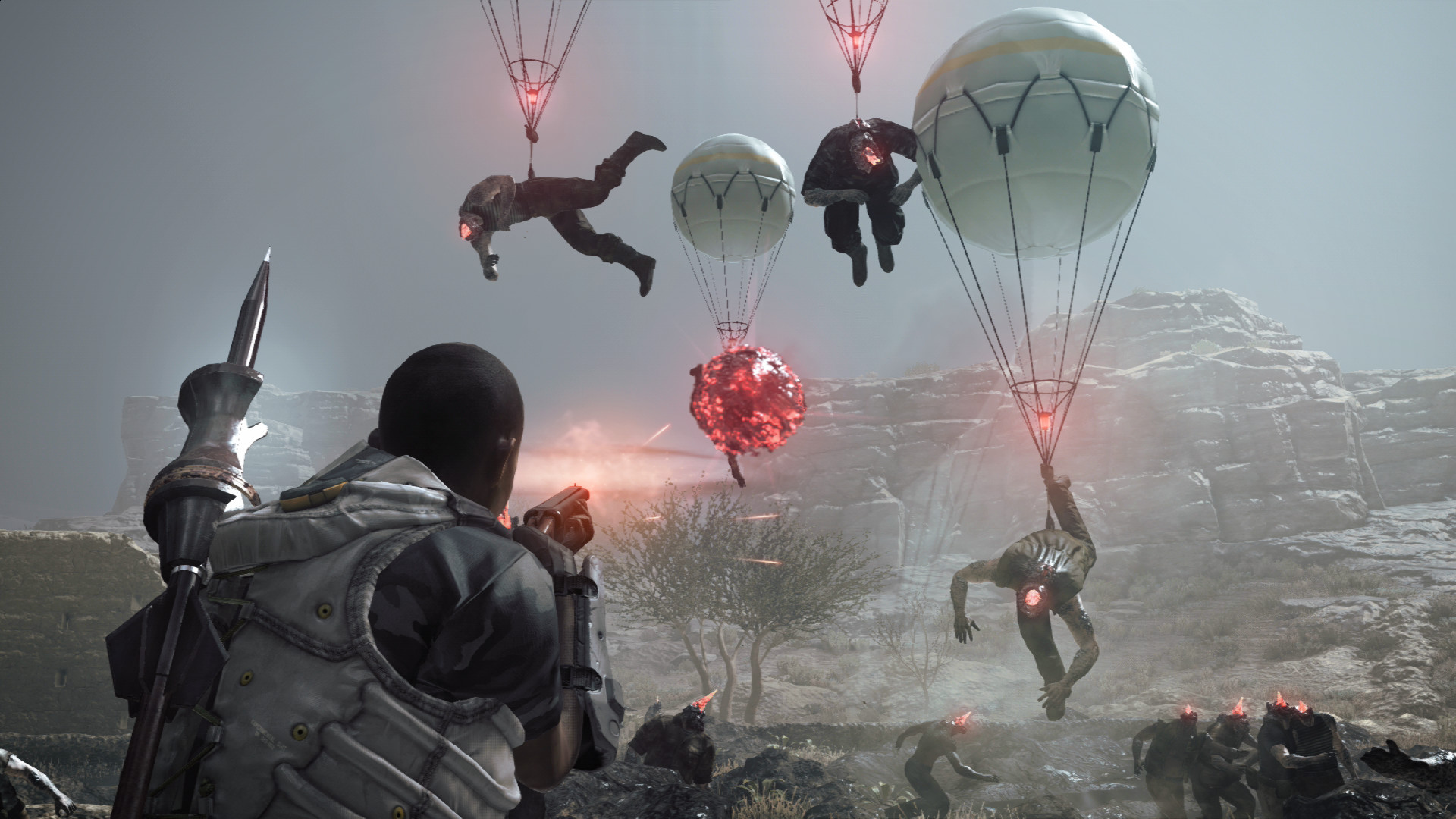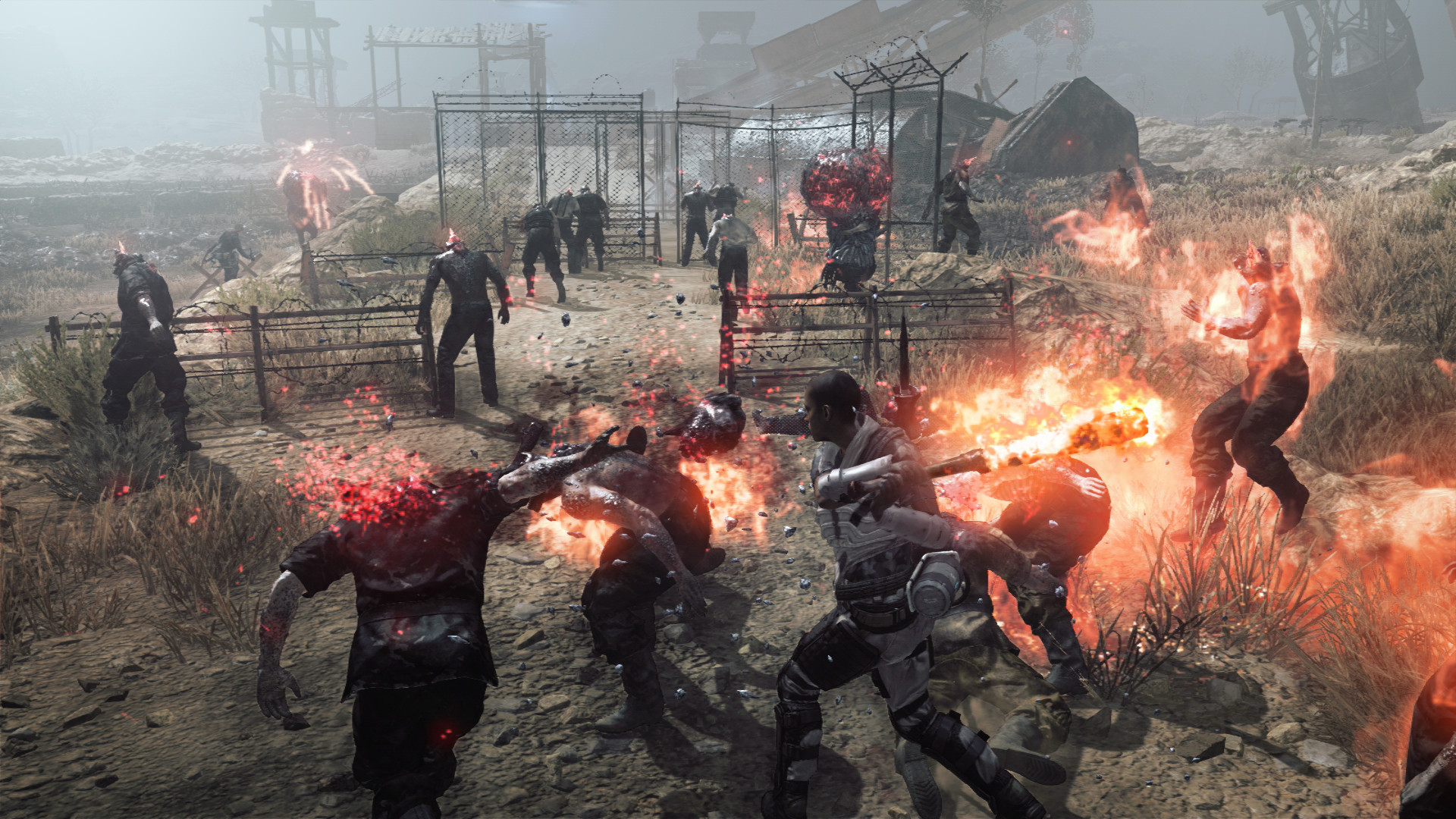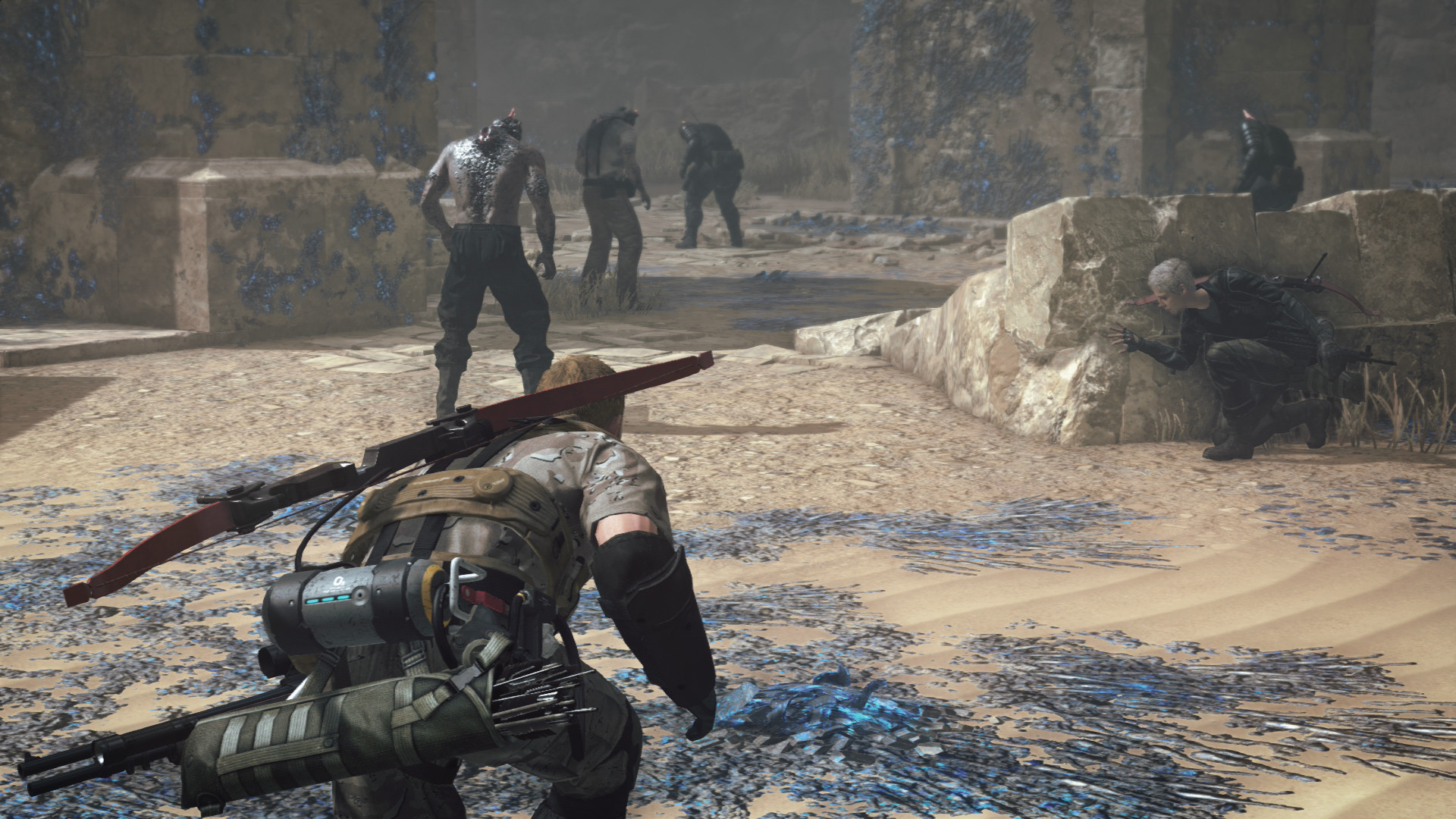Metal Gear Survive Review
Survive is not a Metal Gear game designed by Hideo Kojima, but does that mean it's not worth playing? Here is our review...
Release Date: February 20, 2018Platform: PC (reviewed), Xbox One, PS4Developer: Konami Digital EntertainmentPublisher: KonamiGenre: Survival
I recently heard someone say that it pains them to see the hatred that Alden Ehrenreich has received over his decision to play Han Solo even though he supposedly doesn’t even look like a young Harrison Ford. As that person put it, who – if given the opportunity – wouldn’t love to play Han Solo?
I feel the same way about the staff assigned to develop Metal Gear Survive.
When Konami revealed their intentions to carry on the Metal Gear series following the infamous departure of franchise creator Hideo Kojima, fans feared the worst. As more details regarding the game emerged, those fears were not quelled. A Metal Gear game without Kojima featuring zombies, tower defense, and a seemingly threadbare plot? It was easy to imagine that they viewed the project as little more than a cash-in on the proud Metal Gear name.
Get a Free Trial of GameFly on Us!
The moment you begin playing Survive, though, you’re left with little doubt that those who worked on this game are Metal Gear fans who embraced the opportunity to contribute something to this series. Survive even opens with a surprisingly involved and oddly compelling cutscene that explains just how it fits into the Metal Gear canon. Given that the game’s beta seemed to suggest that Survive’s developers had little interest in explaining why the events in the game’s weird little world were happening, it’s great to see that isn’t the case.
Even better, Survive boasts an oddly compelling narrative. Without giving too much away, you play a custom-built soldier – the game’s character creation option is fairly good – who was in the service of Big Boss sometime during the events of MGS V. Following a large-scale assault on Mother Base and the mysterious appearance of a wormhole, your created hero finds himself in a mysterious world known only as Dite. Your only contact is a man who refers to himself as Goodluck who informs you that you’re going to have to do him some favors if you want to return home.
Due to both the departure of Kojima and Survive’s comparatively smaller budget, this game lacks the grandiose nature of previous Metal Gear plots. There are few epic scenes which leave you trying to figure out just what it was you witnessed, but it’s clear there isn’t a creative mad scientist holding the reins. Still, there is enough plot here to ensure that you’re at least a little curious to see how things unfold.
But what does Survive have the player do between these plot points? Quite a lot, actually. In fact, you may have noticed that those who have played the game sometimes struggle to relay what doing so entails.

Your main goal in Survive is to escape Dite. Doing so entails growing the little base you’ve established by setting-up a staff, defenses, supply stashes, workbenches, and the other such tactical niceties. Acquiring all those things requires you to venture across the world of Dite and collect everything from screws to blueprints for new items. Basically, anything of use that was sent to this world from our own and others we’ve yet to see.
A couple of hurdles stand in your way from building a fortress to the sky that will take you back home. The first is your character’s hunger, thirst, and general health. In order to stay alive in this world, you’ll have to hunt down animals, collect water, and heal your wounds. Because food is hard to come by and water is often tainted, it’s no small feat to stay alive in Dite. You’re constantly searching for life-giving resources.
Hunger isn’t necessarily your greatest concern, though. That honor is reserved for the wanderers who roam this land and look to kill all those who come near. These are the game’s equivalent of zombies and – much like the traditional undead – they are most capable when they’ve gathered in a horde. Even the simplest of weapons can take down a wanderer or two, but a group of these foes out in the wild require you to utilize advanced tactics and weaponry. Of course, you could just utilize your stealth abilities and sneak around them.
However, there is a good reason to kill the wanderers you meet. Each of them possesses Kuban energy crystals which serve a variety of very helpful purposes (most notably, they’re the resource you use to level up your character). As the game plays out and the available unlockables become more advanced, you’ll soon find that there’s quite a bit of incentive to collect as much Kuban as you can.
Unfortunately for you, doing so often means venturing into the dust. Just as it sounds, the dust is a lingering cloud of particles that not only houses the most wanderers but the most valuable resources as well. To even survive in this sea of dust, you’ll need to wear an oxygen mask and keep your tank full. Even then, the wanderers may just kill you long before you ever run out of air.
It’s the dust that makes Metal Gear Survive such an effective horror experience. Wandering through these low visibility areas with only a few lingering lights as your guide is a truly terrifying experience made that much worse by the fact that you need to mind your character’s health. Anyone familiar with the movie The Mist will instantly recognize that it was an obvious influence on the way the dust functions. Survive even features a few Eldritch monsters that wander the deepest parts of this hostile region.
Trips through the dust are unavoidable, though, as is defending your base from attacking hordes of wanderers. The latter threat requires you to utilize the game’s surprisingly complex base building and base defense mechanics to mount a capable resistance against Survive’s increasingly dangerous foes. Once these assaults start, Survive‘s gameplay begins to resemble your basic horde mode with some tower defense mechanics thrown in.

Actually, those assaults are the basis for the game’s co-op multiplayer. There, you and three other players must gather supplies and defend an establishment against waves of enemies while embarking upon missions. Successful – or even unsuccessful – completion of these missions will afford you resources that you can use to build better defenses for subsequent attempts.
You can play the co-op missions with randomly matched companions, but you’re better off playing with friends. The amount of mechanics the game utilizes requires a level of communication that is typically reserved for players that know each other. That’s not to say it’s impossible to achieve success with randomly matched allies, but the mode does seem to offer more enjoyment for those who do so. In any case, the co-op missions offer more than enough gameplay for those who have managed to beat the game’s lengthy campaign.
If you’re looking for a simpler explanation for why you’d want to bother with Metal Gear Survive‘s gameplay package, then just think of Survive as a kind of stealth/horror take on Stardew Valley. That’s probably not the comparison you were expecting, but both games are built upon the simple pleasure of developing a grind-fuelled routine. There’s always something to do in this game and the incentive to earn that next upgrade or make your base just a little more hospitable is usually enough to keep you grinding away for hours. When you’re locked into Survive, you’ll find that a lot of time can pass without knowledge or worry.
Add to that the game’s aforementioned entertaining story, pleasantly familiar stealth elements, and genuinely terrifying moments of pure horror, and you might start thinking that Survive has managed to accomplish the impossible by carrying the baggage of the Metal Gear name and ascending towards greatness.
Sadly, that’s not the case.

In order for a game to invoke a zen-like state of immersion via repetition, it must allow the player to easily establish a gameplay rhythm. Metal Gear Survive fails at that necessary task by forcing players to navigate one of the absolute worst menu systems you’ll ever see in such a menu-heavy game.
Almost everything you do in Survive requires you to navigate a series of menus and submenus. Many times, the menu you need also requires you to access the menu associated with a particular workbench or special item. This often leads to players completing several unnecessary steps. Keep in mind that your food and water levels are constantly ticking down while you’re navigating through all this clutter. Performing seemingly simple tasks like swapping out weapons or ammo types soon becomes a nightmare greater than any contained within the game’s dust.
It’s true that you can eventually learn to master the game’s unintuitive menu system, but even after hours and hours with the game, I never learned to enjoy doing so. Besides, the very moment that the game introduces some new mechanic – which, as you can tell, there are quite a lot of – you’re left having to figure out some new series of inputs which will allow you to just jump back into the core gameplay. For a game that requires so much resource management, Survive makes few efforts to ease the burden of the player.
That burden extends to the game’s survival elements. The amount of food and water your avatar requires is oddly hedonistic for a soldier. It’s going to be quite a long time before you’re able to survive a respectable period of time without having to eat or drink something. It doesn’t help that food is almost always scarce and that water is often dirty and leads to infection. Actually, you acquire the ability to generate a wormhole before you’re able to boil dirty water.
Survive must also bear the burdens of the game it’s built upon. While that statement speaks to the fallout of the Kojima fiasco, it has more to do with the fact that Survive borrows many gameplay elements from MGS V which don’t translate to this type of experience. For instance, Survive makes few changes to Phantom Pain’s combat system which is a bit of an issue when you consider that combat in this game plays a much larger role than it did in MGS V. Mowing wanderers down with weapons is rarely enjoyable and dully exploiting their questionable intelligence with melee attacks isn’t much better. Because they are unarmed, it’s also far too easy to just run around – or through – them if you decide to do so.

Then there’s the issue of the game’s microtransactions. You’ve probably heard that it costs about $10 to even open up a second save slot in Survive – assuming you want to access one right from the start – but that’s just the headline atrocity which may blind you from the fact that one of Survive’s biggest problem is that it often feels like a free-to-play game that costs $40 to play.
The simplest of tasks – such as growing potatoes – take an extreme amount of real-world time to complete. Every time the game annoyingly reminds you that you’re low on food, water, or oxygen – which is quite often – you feel like it’s really telling you to spend a little more cash and make things easier on yourself. It’s the kind of scenario we’re used to seeing in mobile titles, but certainly not in a nearly full-priced release and certainly not in one that bears this name.
There it is again…the legacy of Metal Gearand the burden it bestows. In a perfect world, it wouldn’t impact Survive or your ability to enjoy it. After all, it is clear that many of those who put the work into this game do love Metal Gear as much as its fans do. It’s impossible for any decent Metal Gear fan to not empathize with the situation they were put in.
Yet, empathy only goes so far. I wondered how great Survive would have to be in order to somehow convince the furious Metal Gear fanbase that its mere existence is worthwhile, and it pains me to see that the great game Survive needed to be to achieve that seemingly impossible goal does exist somewhere beneath and amongst the layers of poor decisions which drag this game down faster than its famous name ever could.
